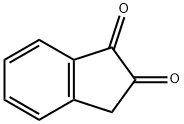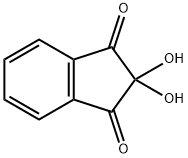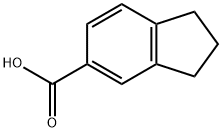1,2-Indanedione
Synonym(s):1H-Indene-1,2(3H)-dione
- CAS NO.:16214-27-0
- Empirical Formula: C9H6O2
- Molecular Weight: 146.14
- MDL number: MFCD00463378
- EINECS: 210-109-7
- SAFETY DATA SHEET (SDS)
- Update Date: 2025-01-27 09:38:02

What is 1,2-Indanedione?
Description
In 1958, IND (1,2-diketohydrindene) was first synthesized by Cava and co-workers. However, in 1997, Dr. Joullie’s research group from the University of Pennsylvania and Ramotowski's research group from the U.S. Secret Service recognized its use as a fingerprint reagent. 1,2-Indanedione (IND) reacts with amino acid contents of latent fingermarks (LFM). IND is an extremely sensitive amino acid reagent that develops latent fingerprints similar to D.F.O. Developed prints may be enhanced with the Zinc Chloride HFE-7100 mixture and visualized under green ALS light (~530nm) with orange or red filtration. It is a fluorescent reagent used to develop LFM on dry, porous surfaces, including thermal papers, due to its high sensitivity towards amino acids[1].
Chemical properties
Solid
The Uses of 1,2-Indanedione
Indan-1,2-dione is a latent fingerprint reagent widely used in forensic chemistry. It can also be used to synthesize polycyclic arene and heteroarene systems containing five membered rings.
References
[1] Sachil Kumar, G. S. Bumbrah, D. Bhagat. “1,2-Indanedione (IND) Reagent for Detection of Latent Fingermarks: A Review.” Shakespeare and the 99% 65 1 (2021).
Properties of 1,2-Indanedione
| Melting point: | 117-124°C |
| Boiling point: | 62-66 °C(Press: 0.1 Torr) |
| Density | 1.310±0.06 g/cm3(Predicted) |
| storage temp. | Sealed in dry,Room Temperature |
| form | powder to crystal |
| color | White to Yellow to Green |
| λmax | 484nm(lit.) |
| InChI | InChI=1S/C9H6O2/c10-8-5-6-3-1-2-4-7(6)9(8)11/h1-4H,5H2 |
Safety information for 1,2-Indanedione
| Signal word | Danger |
| Pictogram(s) |
 Corrosion Corrosives GHS05  Exclamation Mark Irritant GHS07 |
| GHS Hazard Statements |
H302:Acute toxicity,oral H315:Skin corrosion/irritation H317:Sensitisation, Skin H318:Serious eye damage/eye irritation H335:Specific target organ toxicity, single exposure;Respiratory tract irritation |
| Precautionary Statement Codes |
P261:Avoid breathing dust/fume/gas/mist/vapours/spray. P264:Wash hands thoroughly after handling. P264:Wash skin thouroughly after handling. P280:Wear protective gloves/protective clothing/eye protection/face protection. P301+P312:IF SWALLOWED: call a POISON CENTER or doctor/physician IF you feel unwell. P302+P352:IF ON SKIN: wash with plenty of soap and water. P305+P351+P338:IF IN EYES: Rinse cautiously with water for several minutes. Remove contact lenses, if present and easy to do. Continuerinsing. |
Computed Descriptors for 1,2-Indanedione
| InChIKey | WFFZGYRTVIPBFN-UHFFFAOYSA-N |
| SMILES | C1(=O)C2=C(C=CC=C2)CC1=O |
New Products
3-Iodophenylacetic acid 3-Pyridineacetonitrile, α-hydroxy- 2-Propanamine, 1-chloro-, hydrochloride (9CI) 3-(hexyloxy)-4-(pyridin-3-yl)-1,2,5-thiadiazole 2-Hexyn-1-ol Dibenzo-18-crown-6 Nickel(II) perchlorate hexahydrate, 98% 4-Bromophenylacetonitrile, 95% 3-Bromo-4-fluoroaniline, 97% Sodium tetraborate decahydrate, 98% Palladium(II) acetate, trimer, Pd 99% 4-Bromo-2-chlorotoluene, 97% N N Dimethylformamide Dimethyl Acetal (Dmf Dma) 2,3-Dichloro Benzoyl Cyanide [Side Chain] Bis(2-Chloroethyl) Amine Hydrochloride L-Glutamic Acid Diethyl Ester Hydrochloride 5-(Difluoromethoxy)-2-Mercaptobenzimidazole 1-Ethyl-3-(3-Dimethylaminopropyl)-Carbodiimide Hydrochloride [EDC Hcl] 1,4-Napthoquinone Bromoiodomethane Sodium Bicarbonate Methylene Dichloride (MDC) Ethyl Acetate Indole-3-Carbinol (I3C)Related products of tetrahydrofuran








You may like
-
 1,2-Indandione CAS 16214-27-0View Details
1,2-Indandione CAS 16214-27-0View Details
16214-27-0 -
 Indan-1,2-dione CAS 16214-27-0View Details
Indan-1,2-dione CAS 16214-27-0View Details
16214-27-0 -
 17604-74-9 3-Pyridineacetonitrile, α-hydroxy- 98+View Details
17604-74-9 3-Pyridineacetonitrile, α-hydroxy- 98+View Details
17604-74-9 -
 131987-69-4 98+View Details
131987-69-4 98+View Details
131987-69-4 -
 Cyclohexane, (2-propynyloxy)- 67967-07-1 98+View Details
Cyclohexane, (2-propynyloxy)- 67967-07-1 98+View Details
67967-07-1 -
 2-Propanamine, 1-chloro-, hydrochloride (9CI) 98+View Details
2-Propanamine, 1-chloro-, hydrochloride (9CI) 98+View Details
5968-21-8 -
 3-Iodophenylacetic acid 1878-69-9 98+View Details
3-Iodophenylacetic acid 1878-69-9 98+View Details
1878-69-9 -
 132945-75-6 (S)-1-Boc-3-methanesulfonyloxy-pyrrolidine 98+View Details
132945-75-6 (S)-1-Boc-3-methanesulfonyloxy-pyrrolidine 98+View Details
132945-75-6
